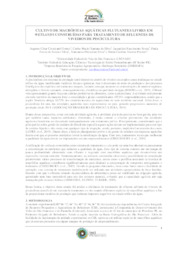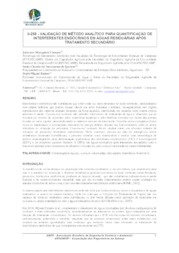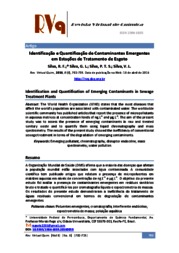Low cost technology can clean hormones and hard-to-remove molecules from the water
Low cost technology can clean hormones and hard-to-remove molecules from the water
A natural water treatment system, constructed wetlands, which uses aquatic plants (macrophytes) to remove pollutants, was proven efficient in eliminating molecules of difficult removal. Known as endocrine disruptors due to their potential to cause changes in human and animal hormonal systems, these substances are a major problem for water treatment companies in big cities (see Bad Waters for Crocodiles below).
The study developed by researchers from the State University of Campinas (Unicamp) and Embrapa were successful in using wetlands on a laboratorial scale to remove three of such disruptors: the hormones ethinylestradiol (EE2) and levonorgestrel (LNG), and the chemical compound bisphenol A (BPA). All of them are considered emerging contaminants and a major concern in the water treatment plants.
The study was developed in the scope of the environmental sanitation technologist Julyenne Campos' doctoral research, advised by the professor from Unicamp's College of Agricultural Engineering (Feagri) Denis Roston and by the Embrapa Environment researcher Sonia Queiroz. The highest efficiency of removing the disruptors was obtained in a system where Campos combined minipapyrus with bamboo charcoal. “The technology she developed presented very promising results and has a large potential for application, including in isolated rural communities”, Queiroz reveals.
The innovation retained a good portion of the contaminants, especially BPA and EE2. Mean retention rates ranged from 9% to 95% for ethinylestradiol, 29% to 91% for bisphenol A, and 39% to 100% for levonorgestrel. The researchers believe that the system can also be efficient in removing other endocrine disruptors with similar characteristics.
“The use of charcoal in wetlands is something new, and according to the results obtained in the study, it proved to be efficient in removing endocrine disruptors”, states Campos, underscoring that the treatment is also promising for the removal of common pollutants present in the sewers. However, she reveals that such kind of wetlands are not often used in Brazil.
“Water is essential for human beings, however, misuse has caused contamination by toxic substances. Hence the need to develop technologies that are efficient and low cost to remoce such contaminants”, states Roston, justifying the motivation behind the PhD project.
Bad water for crocodilesIn the 1980s, a reduction in the population of crocodiles in Lake Apopka, in the American state of Florida, was observed. Investigations discovered changes in the males of the species like low levels of testosterone (male hormone), high concentrations of progesterone (female hormone), smaller penises and reproductive flaws. Such modifications were caused by the pesticide DDT, which was banished later on. This became a classic example of the effect of the so-called "emerging contaminants” that encompasses several chemical products like dyes, drugs, estrogens, polymers and others that through different ways end up contaminating bodies of water, many of which supply cities. Without affordable treatments to remove them from the water, or even methods to identify their presence, these new contaminants are a concern worldwide and their effects on human health and the environment have been discovered in the last few decades by scientific research. Some countries have adopted expensive methods to clean water and mitigate such effects. The findings from the research conducted by Julyenne Campos are relevant because they have the potential to generate a simple solution that is affordable for poor countries. |
How does it work?
Campos explains that constructed wetlands are a sewage treatment systems that transform pollutants through the microorganisms existing in a biofilm that is trapped in the supporting medium (generally sand or gravel). The macrophytes are responsible for performing a process known as phytoremediation.
“These systems have several advantages, such as the low cost of implementation and maintenance, the efficiency in removing several kinds of contaminants and the low electricity requirement, and are thus suitable for implementation in isolated rural communities", stresses the technologist.
The kind of charcoal normally used for water treatment is the activated one, but the bamboo charcoal used in this study was a common one. “In my PhD research, we made physical-chemical and microbiological tests, and I even studied this charcoal during an academic exchange in Spain, in a laboratory specialized in charcoal trials, but, unfortunately, we could not elucidate the action mechanisms of this non-activated bamboo charcoal", she informs.
Although she does not know precisely how the system works yet, one of her hypotheses is that there was greater adherence of the biofilm to the bamboo surface in comparison with the surface of gravel, providing a higher amount of microorganisms and consequently greater degradation rates. “However, the processes involved in the removal are not clear yet, and more studies are necessary to better understand the complexity of the processes that occur inside the environment of constructed wetlands”, she reports.
Endocrine disruptors in action
These substances can cause undesired effects, as they can bind to the hormone receptors present in the cells of living beings, and take the place of natural hormones, which in turn can no longer bind to the receptors and thus cease to work. That is harmful to the endocrine systems of animals in general, including human beings. These effects can occur even with extremely low concentrations of endocrine disruptors.
The effects caused by such molecules are cancer, mutagenicity (disturbance that affects the cell DNA, which can pass changes on to descendants) in the reproductive parts of the animal species present in aquatic biota, sterility in men, early menarche (first menstruation), feminisation and development of ovarian cavities in male fish, presence of male traits and masculinization of female fish, thyroid problems, among others.
Due to the risks to health and to the environment, these pollutants have generated great concern. These substances are increasingly more present in the environment, especially in rivers and lakes; hence the need for studies that involve methods to monitor them in the environment and in the water, in order to assess the impact on human health, animals and the environment, and for the development of technologies to remediate and mitigate the presence of these contaminants.
These contaminants are found in residual waters, surface waters and even in underground waters at variable concentrations, according to studies conducted in France, Korea, Germany, Italy, Switzerland, the United kingdom and the United States, evidence it is a world issue.
Photo: iStock
Translation: Mariana Medeiros
Cristina Tordin (MTb 28.499/SP)
Embrapa Environment
Press inquiries
meio-ambiente.imprensa@embrapa.br
Phone number: +55 19 3311-2608
Further information on the topic
Citizen Attention Service (SAC)
www.embrapa.br/contact-us/sac/




